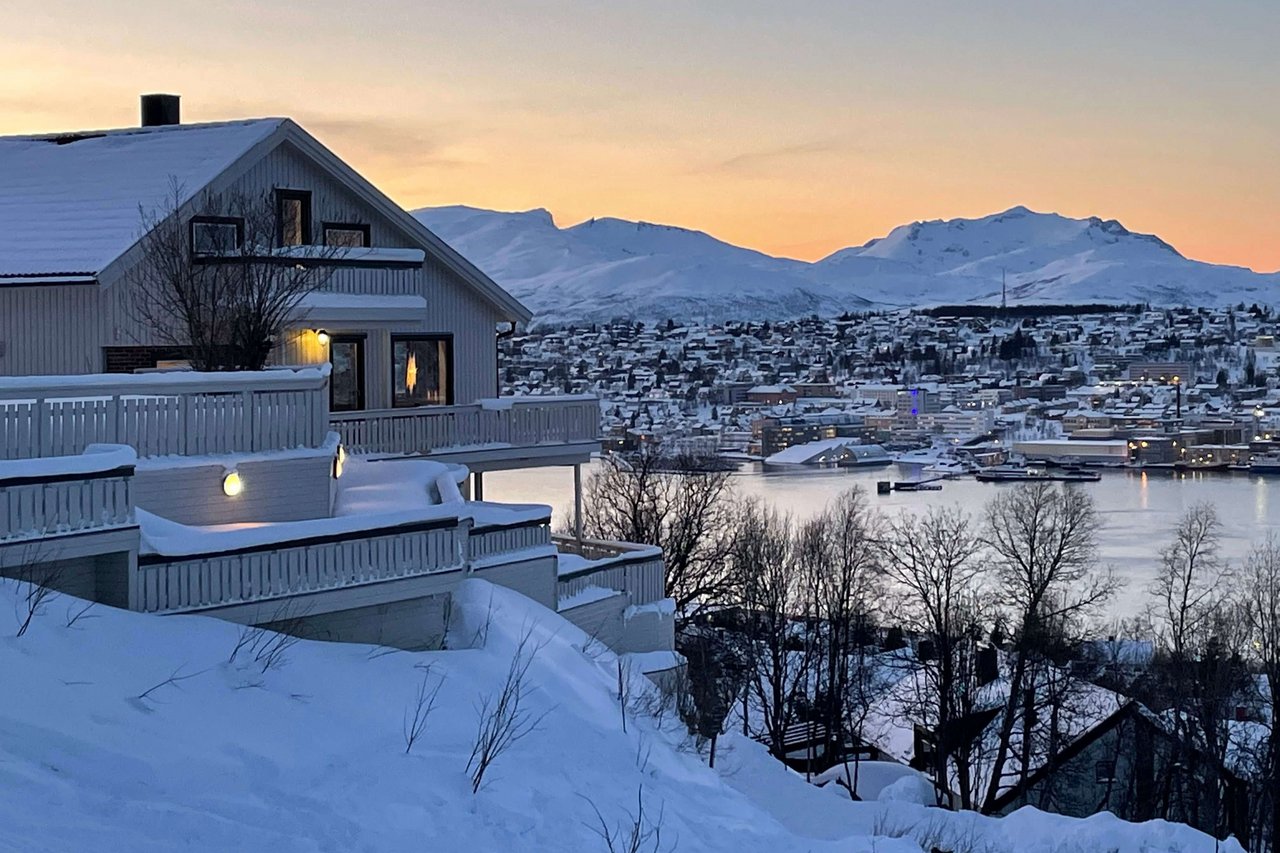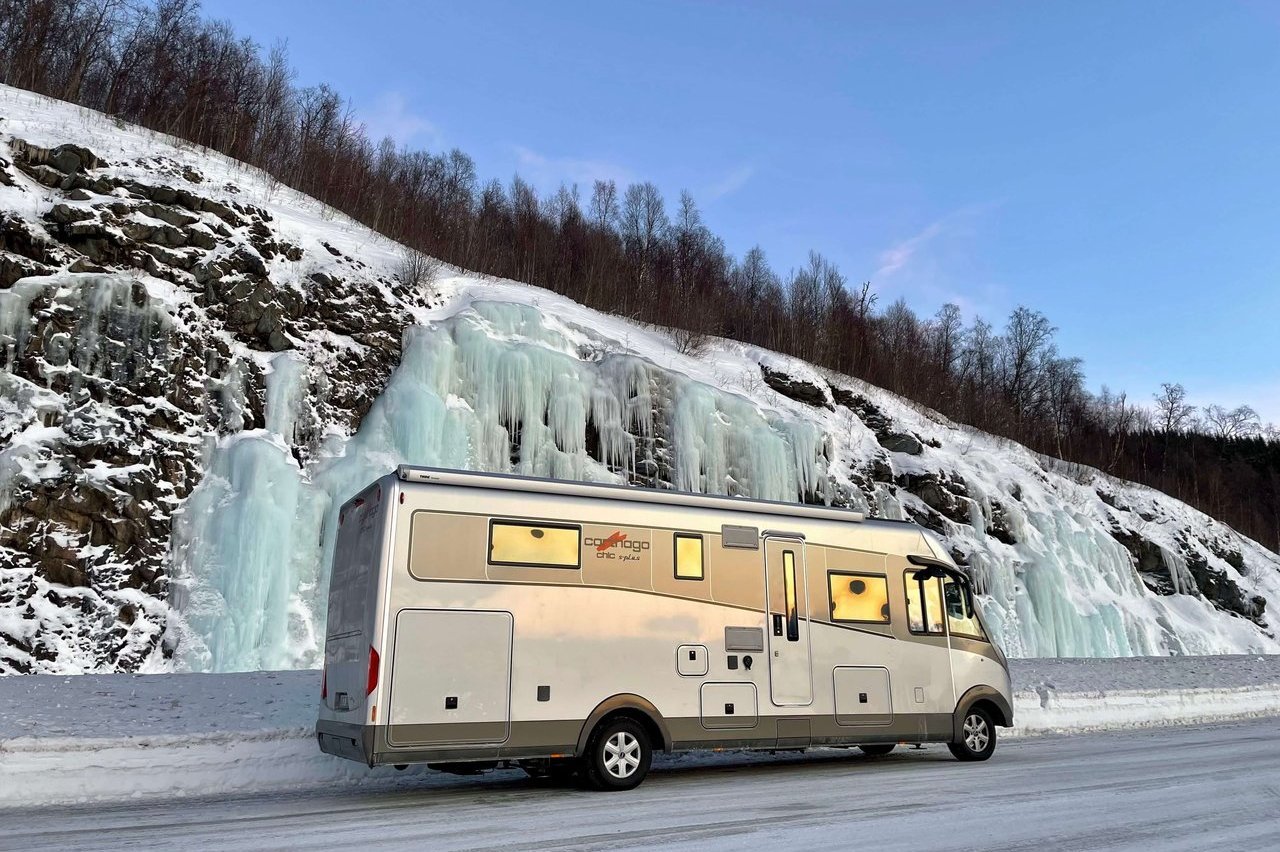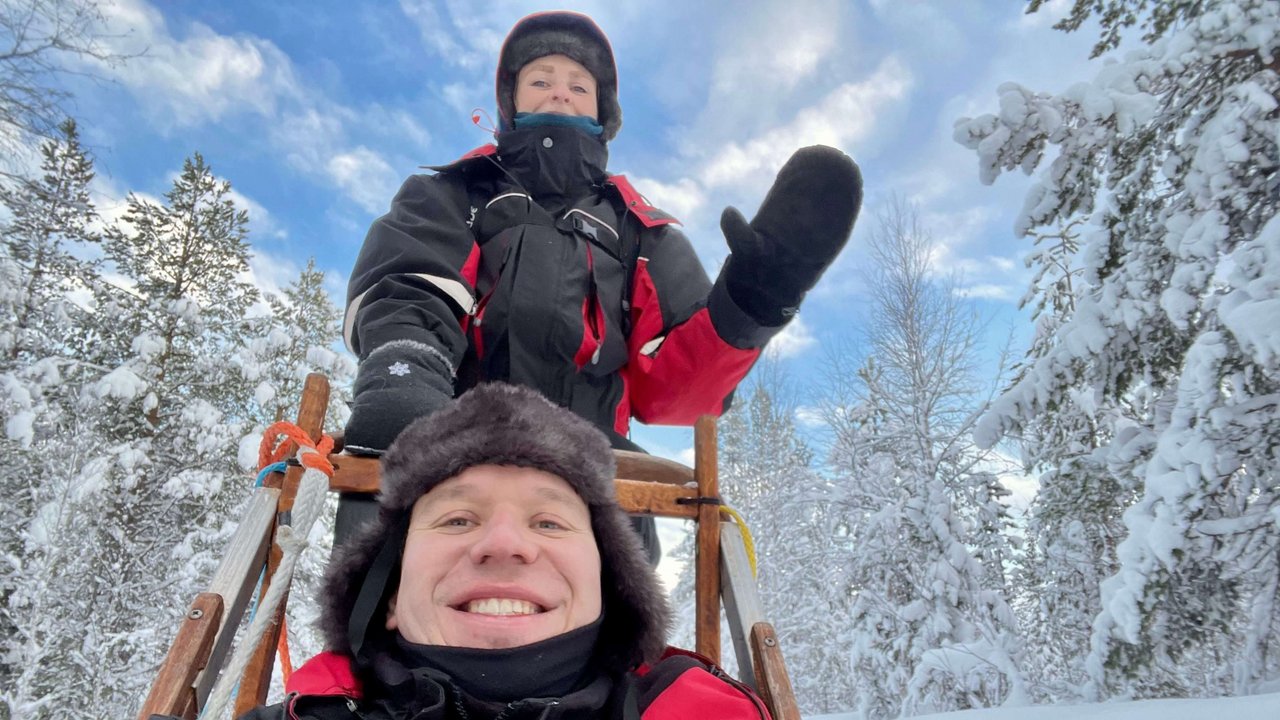Experience the Northern Lights with the chic s-plus
Our customers Lena and Sven told us about their exciting trip through Scandinavia in winter with their chic s-plus I 64 XL QB. Of course we don't want to keep these great experiences from you! If you are also considering travelling to Scandinavia with your motorhome, you will find helpful tips in their report.
An adventurous journey with our Carthago "Eleanore”
Preparations for the motorhome and for us
It was supposed to be an adventure. And it was. After Corona threw a spanner in the works for the last two years, it was finally to be this winter: a 3-week (belated wedding) trip to the north of Sweden and Norway with our Eleanore.
Eleanore is our Carthago s-plus I 64 XL QB, which we have been able to call our own since 2020 as the third Carthago in a row.
A holiday of this kind naturally requires a lot of planning and preparation. So before we even started, Eleanore had to be thoroughly checked out and (like us) equipped with the appropriate gear. A detailed list of all points can be found at the end of the travel report.
Obligatory in our luggage: a DJI Mavic Air 2 drone, a GoPro 10 action cam and our Camping Cat Cleo.
The route by motorhome
We started in Munich, took the ferry from Rostock to Trelleborg, then along the east coast of Sweden to Luleå, from there inland to Kiruna, across the border to Norway up to Tromsø, then south again via the Lofoten Islands, back to Sweden at Bodø and back through the centre of the country to Trelleborg, Rostock and Munich.
The first polar lights
Sweden greeted us with rain and single-digit temperatures. In order to finally begin our winter adventure, we drove quickly to the Arctic Circle within two days. After a few hours, the rain slowly turned into snow.
In Gammelstad, the historic church village of Luleå and a UNESCO World Heritage Site, we were also able to marvel at the first slight glimmer of polar lights. We didn't know at first: were they just clouds on the horizon, or were we graced with polar lights directly on the first evening? The latter was the case! So we immediately pulled out the camera and captured the experience.
The journey continued inland. A winter wonderland spread out before us as we drove through endless forests on lonely roads, which by now were only hard ice roads. The temperature dropped by the minute and reached a new record of -33 degrees when we arrived at our overnight campsite. During the night it was supposed to drop to -38 degrees.

A special evening atmosphere
We were lucky with our place to stay overnight, because due to the masses of snow that had accumulated over the last few weeks, most of the side roads and rest and parking areas were not cleared or only sparsely cleared (there was not more than one small parking bay). Parking spaces, which are indicated in common apps such as Park4Night, were therefore simply not available. In the loneliness of northern Sweden with only one known campsite in Kiruna (Sweden's northernmost city and the world's largest iron ore mine), the tour should therefore be well planned for anyone with fewer reserves and capacities. However, we were able to let ourselves drift because of our equipment.
Here too, in a lonely spot directly on a frozen lake, a northern lights spectacle unfolded above us, which we captured with our GoPro on a tripod. But the pictures and videos are nothing compared to the live natural spectacle, which is hard to put into words.









Important tips for the sub-zero temperatures
The temperatures, however, gave us a hard time. Despite the 90-litre gas tank, which was still half full at the time, the temperatures in the motorhome slowly but steadily dropped to only 16 degrees. The reason: our LPG mixture (propane/butane) still contained a not negligible amount of butane due to residual stocks from previous holidays. However, butane has the property that it no longer evaporates properly above 0 degrees. At minus temperatures in the double-digit range, it was therefore unusable.
We can only give everyone the tip here: It is essential to visit a gas filling station that offers a proven mixing ratio of 95/5. Be sure to use up any remaining butane in advance. Our two gas bottles, which contained pure propane gas, provided the remedy. Finally, it should be mentioned here that, depending on your personal feeling of warmth, it may be advisable to plug into electricity for more heating power in order to be able to use an additional 3 kW or to save gas.
Another tip: Be sure to use the engine preheater beforehand! In the prevailing weather conditions, the engine oil can become viscous, making it difficult to start the engine. We switched it on about 30 minutes before departure. Due to the extreme cold, the engine still stuttered several times when starting and made our hearts drop. After a few seconds of shock, however, the engine started. For the first time, the effect of this system became apparent.
Relieved, we drove off, only to be confronted with the next bad news after a few kilometres: "AdBlue error" appeared on the display. In addition: "Remaining range 250 km". We could not go to an IVECO service partner. Because the options here were: Drive about 350 km east to Luleå, or drive about 400 km west to Tromsø. So we only had the option of visiting all the garages in Kiruna. The fifth workshop was able to help us and read out and delete the error.
Here, too, the cold was the cause of the problem: AdBlue freezes from -11 degrees. So we simply froze the AdBlue! The tank does have a heating coil inside, but this is only active when the engine is running and is not made for these extreme conditions. This is one of the reasons why you often see trucks with running engines in these latitudes.
The workshop's tip: Do not fill the AdBlue tank. This way, at least warm AdBlue can be refilled and the thawing of smaller quantities is quicker than would be the case with a 20-litre lump. Unfortunately, we had always filled up the tank, assuming that it was the same as with diesel, which should ideally be filled up at such temperatures.
We then moved on to the border to Norway as planned, encountering a small herd of reindeer and even an elk at the side of the road, but then suddenly the power dropped and the engine went into emergency mode - despite the fault being cleared and the warning light not being on since then.
After consulting our IVECO dealer in Munich, we learned that the engine should not be switched off in such a case, as there was a possibility that it would then no longer start, and as the prevailing temperatures were still -30 degrees, we had no choice but to make our way to the nearest IVECO service partner.
We crawled on with reduced power for the remaining 250 km or so and reached the campsite in Tromsø around 10 pm. At the risk of having to be towed from there to the service partner, we turned the ignition off - and on again. And lo and behold, the engine started and the emergency running programme was gone!
So should we have made a fresh start beforehand? No! Because we didn't want to and couldn't take the risk of getting stranded at -30 degrees. Nevertheless, we wanted to visit the IVECO service partner just to be on the safe side. But before that we enjoyed our stay in Tromsø with a view of more polar lights directly above our heads, which immediately compensated for the suddenly seemingly insignificant problem. The next day (sunset was at 14:38) we also enjoyed a cable car ride up the local mountain Storsteinen and a hike with spikes under our shoes, which were absolutely necessary.










Meanwhile, we put the electric fan heater under the vehicle to heat the tank from the outside. Somehow paradoxical! A system to protect the environment has to be defrosted elaborately by means of an electricity consumer. Even the local temperatures of -9 degrees no longer posed any major problems. The IVECO workshop nevertheless detected a temperature of -10.5 degrees inside the tank the following day. The only solution: head south to "warmer" climes.
Skiing with a sea view
Our rough plan was to continue on to Lofoten anyway. At that time, the temperature was almost summery at -1 degrees. However, we made a stopover in Narvik, made famous by the "Battle of Narvik" in 1940, to test the ski area there, which during the week actually only opened at dusk at 3 pm with partial lighting of the slopes. Skiing with a view of the sea - that was also a novelty for us.









Places that should be visited as well
On the Lofoten Islands, we once again visited the well-known highlights that we had already experienced on our summer trip in 2018 with our then c-tourer: Henningsvær with its famous football field, the lonely fishing village of Nusfjord, Reine with its impressive mountain scenery and Å, the place with the shortest name in the world.

















A real adventure: on the road with the sled dogs
Originally we wanted to go to Andenes for a whale safari, but unfortunately the winter season (end of October to mid-January) was already over. So we took a diversion (the ferry Moskenes - Bodø was unfortunately cancelled at short notice due to lack of staff) back to Sweden. Next stop: dog sledding tour!
Malin (Swedish sled dog racing champion) and Lars (also an experienced sled dog racer) from Cold Nose Huskies were our target of desire. With our personal guide Connor and a total of 14 dogs on two sleds, we were treated to a unique experience that we will never forget and which definitely made it into the top 3 of our travel experiences so far. We glided through untouched snow scenery in the depths of Lapland's forests on our 6-hour day tour - including moose sightings! We learned a lot about the dogs (Alaskan huskies), the husky farm and sled dog races and were able to enjoy the silence of nature during a break (keyword: Sound of Silence).











Camping tip
After a tip from Lars, we spent the night at the nearby campsite in Sorsele. Sandra and Jens, the campsite operators, organised a snowmobile tour with a local provider the next day. This tour was also an unparalleled experience. The route led over frozen lakes, through forests in the hinterland and through deep snow - with top speeds of up to 80km/h.
The journey home
Unfortunately, we had to start our journey home again. On the way south, we made a stop at Värmlands Moose Park to see five moose in their natural habitat, in addition to the numerous moose we spotted at the roadside. Here, too, we learned a lot about the local fauna and flora.
Our last stop was RV Masters, a company that specialises in customised windscreen covers for camping vehicles. We had already ordered two covers for summer and winter here before the start of our holiday and had now picked them up. Robert and Ingrid, themselves enthusiastic motorhome drivers, installed them on site.
The special feature: the covers are attached by means of magnets. This saves rubber clamps or suction cups. This is particularly helpful for higher vehicles such as our s-plus.
In the end, Sweden bid us farewell just as it welcomed us: With rain and single-digit temperatures in the plus range. But this could not dampen our spirits. Strengthened by numerous wonderful moments and memories in our heads, we sailed back to Germany overnight.
Our conclusion of this trip: We wanted an adventure and we got an adventure. Scandinavia in winter has certainly not seen the last of us - despite some problems. We are already planning our next winter tour to the north and are full of anticipation.
Our Eleanore has put up a brave fight. The problems we have described here were either IVECO-specific or home-made (you never stop learning). Nevertheless, one should prepare well and have alternatives (e.g. another heating possibility) as well as reserves (e.g. sufficient gas) available.
We thought we had prepared for all eventualities, but we definitely didn't expect our AdBlue to freeze. We are now wiser and will take the tips we were given on this trip to heart next time.
As far as the roads are concerned, the roads in northern Sweden and Norway are not cleared of ice. Instead, grooves are cut into the ice. But here, too, the usual rules apply: no jerky steering movements and no heavy braking. Instead, use the engine brake and thus decelerate. We also regularly tested the road conditions and our skills through controlled starting, braking and evasive manoeuvres. A rear-wheel drive definitely has an advantage here.









In total, we were lucky enough to marvel at the polar lights seven times. Depending on the strength of the storm, sometimes they were only hints, which only really came into their own in photos and videos. Other times, they were light drawings visible to the naked eye, shimmering green/white/red above our heads in the starry sky. We will never forget this sight.











You can find us on social media
More impressions, also from our previous trips with the motorhome, can be found on our YouTube channel.
| YouTube channel |
Precautions/checklist before and during the journey
In addition to a general (winter) check of the vehicle, we had also worked through the following points:
- Check all fluids (engine oil, wiper fluid, brake fluid, etc.).
- Check all lighting equipment
- Check tyre pressure and condition (do not forget a spare wheel), if necessary adjust the pressure at the destination.
- Check the old liquid level in the tank (should be approx. 1 cm above minimum when cold).
- Grease rubber seals on doors and flaps
- Oil door hinges and locks
- Oil the steps in the living area and driver's cab and regularly remove dirt on site.
- Lubricate other vulnerable moving parts on superstructures and attachments, e.g. on the SAT system.
- Making the compressed air reservoir of the air suspension frost-proof
- Eliminate possible cold bridges (e.g. insert seals in roof windows with forced ventilation, lay carpet / Armaflex insulation in double floor, use additional cab floor insulation).
- Putting on snow chains trial
All fluids and lubricants should be carried as a reserve to be refilled on site if necessary.
Otherwise, the following items should be packed as a precautionary measure, if they are not already part of the basic equipment:
- Spare wheel including wheel change equipment
- Snow chains
- Water taxi or bucket for the disposal of grey water (ground inlets are usually inaccessible or out of order at this time of year).
- Waste water hose for the disposal of black or grey water
- Sufficiently long garden hose to supply fresh water (water taps might only be available inside - but some petrol stations offer the option of filling up with water at a pillar).
- Bucket Split for Grip
- Bucket of salt for ice removal
- Mud flaps (very helpful against ice and snow clods under the entire vehicle).
- Reserve gas bottles (refilling and exchange stations are rare, especially in the north).
- Matching LPG gas filling adapter set
- Electric fan heater (or other heating options if the heating system fails)
- Snow shovel
- Spade and/or folding spade
- Broom
- Work gloves
We also dressed accordingly for the cold temperatures and weather conditions:
- Winter boots with a sufficiently high shaft (for deeper snow) and a comfort temperature down to -20 degrees
- Slip-on spikes for winter boots
- Merino wool socks
- Thermal underwear
- Functional clothing (onion-skin principle)
- Tube scarf
- Ski cap with ears
- Undergloves
- Finger gloves
- Mittens
- Hand and sole warmer
We always travel true to the motto: Better to have and not need than to need and not have.













